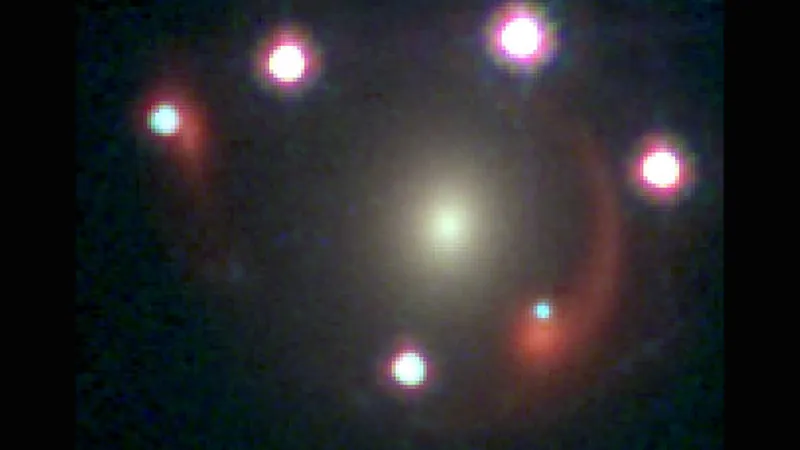
Breakthrough Discovery: James Webb Space Telescope Captures First-Ever 'Einstein Zig-Zag' Image — Here’s What It Means for Cosmology!
2024-11-21
Author: Kai
Introduction
In a stunning revelation, astronomers using the James Webb Space Telescope (JWST) have unveiled the first-ever 'Einstein zig-zag,' showcasing an image of a quasar—an exceptionally brilliant galactic core—repeated six times in a single view. This rare phenomenon is attributable to a concept initially posited by Albert Einstein in 1915, known as gravitational lensing. Such a finding has scientists buzzing with excitement, as it holds the potential to resolve critical issues in cosmology.
Details of the Discovery
Designated J1721+8842, this fascinating system features a quasar that is lensed by not one, but two galaxies that are aligned just perfectly. This extraordinary cosmic spectacle provides a vital glimpse into the dynamics of spacetime—an effect that general relativity elegantly explains. The implications of this discovery stretch far beyond mere curiosity; it promises new insights into two of cosmology's biggest puzzles: the enigmatic nature of dark energy and the inconsistencies observed in measuring the Hubble constant, the rate of the universe's expansion.
Expert Reactions
"We are ecstatic about this discovery,” stated Martin Millon, a cosmologist from Stanford University and a member of the research team. "This configuration not only represents an exciting natural phenomenon but also enhances our ability to accurately measure essential cosmological parameters."
Understanding Gravitational Lensing
Gravitational lensing occurs when massive objects warp the fabric of spacetime, causing light from distant background sources to bend around them, creating multiple images in the process. In this case, the alignment of both galaxies with the quasar has produced a unique configuration known as the 'Einstein zig-zag,' allowing scientists to observe the same quasar in six distinct positions within a single snapshot.
Historical Context
Interestingly, the J1721+8842 quasar was first identified in 2017 by Cameron Lemon using the Panoramic Survey Telescope and Rapid Response System (Pan-STARRS) in Hawaii, where it appeared to form only four images. Thanks to the advanced sensitivity of the JWST, researchers have since uncovered its complex nature, revealing the additional images produced by this precise alignment of galaxies.
Rarity and Significance
"This configuration is exceptionally rare—about one in 50,000 lensed quasars could exhibit such an alignment," noted Frédéric Dux, the lead author from the EPFL Laboratory of Astrophysics. The closest galaxy lensing the quasar is estimated to be 2.3 billion light-years away, while the more distant galaxy is about 10 billion light-years from Earth. Despite the astronomical distances between these galaxies, their alignment allows for a unique opportunity to study light emitted by a quasar over 11 billion light-years away.
Addressing Cosmological Challenges
This discovery holds hope in tackling the 'Hubble tension,' a discrepancy between the Hubble constant values derived from observations of the early universe and those determined within the local cosmos. With the JMST's findings, researchers have better constraints for these measurements, potentially narrowing down discrepancies.
Insights into Dark Energy
"Part of the issue lies in uncertainties in these measurements," Dux elaborated. "Using the Einstein zig-zag lens, we could bring the two conflicting values closer together, allowing for a clearer understanding of the expansion of our universe."
Future Discoveries
Moreover, the benefits of J1721+8842 extend beyond just resolving the Hubble tension; it can also provide insights into the equation of state for dark energy, the mysterious force driving the universe's accelerating expansion. As Dux indicates, "By employing this lens, we hope to simultaneously determine both values more accurately, a feat rarely achievable."
Ongoing Research
Additionally, this discovery opens up intriguing prospects for studying the distant galaxy acting both as a lens and a light source. "We stand on the brink of answering essential questions about its mass and star formation history," Dux said.
Conclusion
While the JWST has played a crucial role in pinpointing the extraordinary configuration of J1721+8842, the quest for more 'Einstein zig-zag' arrangements continues. As researchers strive to unlock more cosmic secrets, they remind us that each of these discoveries brings us one step closer to unraveling the mysteries of our universe. Stay tuned, because the cosmos has only just begun to open its doors!



 Brasil (PT)
Brasil (PT)
 Canada (EN)
Canada (EN)
 Chile (ES)
Chile (ES)
 España (ES)
España (ES)
 France (FR)
France (FR)
 Hong Kong (EN)
Hong Kong (EN)
 Italia (IT)
Italia (IT)
 日本 (JA)
日本 (JA)
 Magyarország (HU)
Magyarország (HU)
 Norge (NO)
Norge (NO)
 Polska (PL)
Polska (PL)
 Schweiz (DE)
Schweiz (DE)
 Singapore (EN)
Singapore (EN)
 Sverige (SV)
Sverige (SV)
 Suomi (FI)
Suomi (FI)
 Türkiye (TR)
Türkiye (TR)